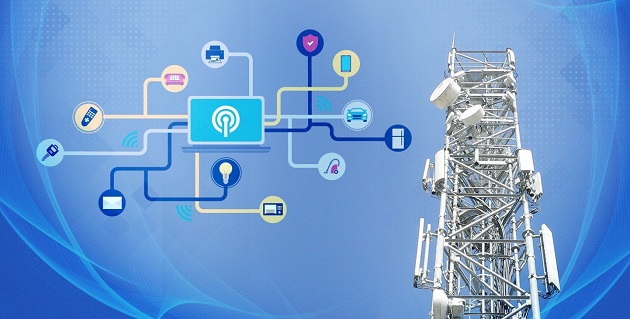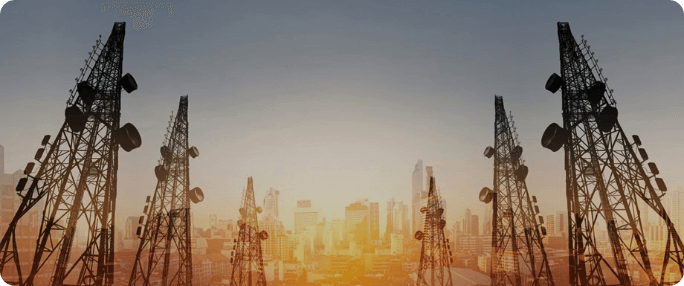Global Forum For Indurstrial Devlopment is SPONSORED BY ICO INDIA
- MP Society Registration (Act. 1973 No. 44) 03/27/01/21857/19 (MSME Forum Established Since-2009)

Telecommunication is the transmission of information by various types of technologies over wire, radio, optical, or other electromagnetic systems. ... Such transmission paths are often divided into communication channels, which afford the advantages of multiplexing multiple concurrent communication sessions.
telecommunication, science and practice of transmitting information by electromagnetic means. Modern telecommunication centres on the problems involved in transmitting large volumes of information over long distances without damaging loss due to noise and interference. The basic components of a modern digital telecommunications system must be capable of transmitting voice, data, radio, and television signals. Digital transmission is employed in order to achieve high reliability and because the cost of digital switching systems is much lower than the cost of analog systems. In order to use digital transmission, however, the analog signals that make up most voice, radio, and television communication must be subjected to a process of analog-to-digital conversion. (In data transmission this step is bypassed because the signals are already in digital form; most television, radio, and voice communication, however, use the analog system and must be digitized.) In many cases, the digitized signal is passed through a source encoder, which employs a number of formulas to reduce redundant binary information. After source encoding, the digitized signal is processed in a channel encoder, which introduces redundant information that allows errors to be detected and corrected. The encoded signal is made suitable for transmission by modulation onto a carrier wave and may be made part of a larger signal in a process known as multiplexing. The multiplexed signal is then sent into a multiple-access transmission channel.
The simplest form of telecommunications takes place between two stations, but it is common for multiple transmitting and receiving stations to exchange data among themselves. Such an arrangement is called a telecom network. The internet is the largest example of a telecommunications network. On a smaller scale, examples include the following:
1.corporate and academic wide area networks (WANs)
Telecommunications systems are generally run by telecommunications service providers, also known as communications service providers. These providers historically offered telephone and related services and now offer a variety of internet and WAN services, as well as metropolitan area network (MAN) and global services.
 In many countries, telecom service providers were primarily government-owned and -operated. That is no longer the case, and many have been privatized. The International Telecommunication Union (ITU) is the United Nations (UN) agency that administers telecommunications and broadcasting regulations, although most countries also have their own government agencies to set and enforce telecommunications guidelines. In the United States, the Federal Communications Commission (FCC) is the primary regulatory agency.
In many countries, telecom service providers were primarily government-owned and -operated. That is no longer the case, and many have been privatized. The International Telecommunication Union (ITU) is the United Nations (UN) agency that administers telecommunications and broadcasting regulations, although most countries also have their own government agencies to set and enforce telecommunications guidelines. In the United States, the Federal Communications Commission (FCC) is the primary regulatory agency.
1. AT&T
2.Verizon
3. Nippon Telegraph and Telephone (NTT)
The GFID INDIA issues visa recommendation letters to representatives of organisations wishing to travel overseas for promotion of business and other related activities. Certain embassies/countries request for certification of visa application by the recognized Chambers. The GFID INDIA Visa Documentation helps in processing the visas of member and non-member firms.
The firms desirous of obtaining recommendation letters for issue of visa are requested to furnish the following documents to the GFID INDIA at the time of applying:
1. Request letter addressed to the GFID INDIA, on the original letterhead of the firm (application format to be obtained from the Visa Recommendation Department of GFID INDIA)
2. Photocopy of the passport of the person applying for the visa.
3. Photocopy of the invitation letter received from the country to be visited.
The request letter should be signed by a senior officer of the firm and not the person applying for the visa. All photocopies must be certified with signature and stamp of the person signing the application.
Only documents received in hard copy will be processed. Documents received by 3 pm will be processed the same day.
Payment must be made through Demand Drafts / NEFT transfer / Cash. No cheques will be accepted.
The GFID INDIA issues visa recommendation letters to representatives of organisations wishing to travel overseas for promotion of business and other related activities. Certain embassies/countries request for certification of visa application by the recognized Chambers. The GFID INDIA Visa Documentation helps in processing the visas of member and non-member firms.
The firms desirous of obtaining recommendation letters for issue of visa are requested to furnish the following documents to the GFID INDIA at the time of applying:
1. Request letter addressed to the GFID INDIA, on the original letterhead of the firm (application format to be obtained from the Visa Recommendation Department of GFID INDIA)
2. Photocopy of the passport of the person applying for the visa.
3. Photocopy of the invitation letter received from the country to be visited.
The request letter should be signed by a senior officer of the firm and not the person applying for the visa. All photocopies must be certified with signature and stamp of the person signing the application.
Only documents received in hard copy will be processed. Documents received by 3 pm will be processed the same day.
Payment must be made through Demand Drafts / NEFT transfer / Cash. No cheques will be accepted.